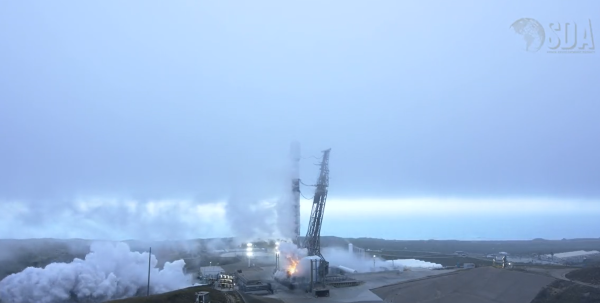
The U.S. Space Development Agency (SDA) launched 10 satellites on April 2 from Space Launch Complex 4E at Vandenberg Space Force Base, California, on a SpaceX Falcon 9 rocket, sending the first set of satellites for its Proliferated Warfighter Space Architecture to orbit.
The reusable stage one booster returned and touched down at Landing Zone 4 about 8 min. after the 7:29 a.m. PDT launch.
This new era of proliferated satellite launches has been four years in the making. In March 2019, then-Defense Secretary Patrick Shanahan established the agency, drawing on the ideaa—now proved out by SpaceX and OneWeb—of launching hundreds or even thousands of satellites to low Earth orbit.
“SDA was established to be a constructive disrupter within the Department of Defense to demonstrate a completely new way to field space capabilities and to operate them,” Director Derek Tournear says. “We essentially have developed an architecture based on two pillars. Pillar number one is proliferation, hundreds and hundreds of satellites. Pillar number two is spiral development. That means that we’re going to launch our spirals, or tranches, essentially every other year.”
This Tranche 0 launch carried two spacecraft made by SpaceX designed for missile tracking, which are between 1,300-1,500 kg (2,870-3,3090 lb.) each, equipped with two optical communications terminals and a wide field-of-view sensor payload. The other eight satellites are spacecraft of about 200 kg each for SDA’s communications “transport layer.” They were made by York Space Systems. Five of those are mesh-node satellites with two optical communications terminals and the ability to receive and transmit radio frequency signals. The other two include a tactical data link receive and transmit capability.
SDA plans to launch another 18 satellites—six tracking and nine transport—in June. That batch includes 12 for the transport layer—two made by York and 10 made by Lockheed Martin. The remaining six are tracking satellites—two more made by SpaceX and four by L3Harris Technologies. This initial Tranche 0 will cost $980 million, including the cost of purchasing satellites, launches, the ground segment, and operations and maintenance through 2025, according to Tournear.
Once Tranche 0 satellites are checked out on orbit, SDA will begin to demonstrate the feasibility of a proliferated architecture for beyond line-of-sight targeting and for advanced missile detection and tracking of hypersonic weapons.
SDA will be testing the satellites’ capabilities at Eglin AFB in Florida to demonstrate connectivity using land-based Link 16 radios. The agency had planned to participate in the Northern Edge exercise but has not received authorization from the FAA to transmit over Link 16, Tournear said. “We’re hoping that we get that approval right after we’re done with tests and checkout so we can start that on the order of two months,” after the launch he said.
Instead of the multi-service Northern Edge exercise based in Alaska, SDA plans to participate in Marine Corps exercises in the Indo-Pacific Command region in late summer. SDA also is working with a Warfighter Integration Cell in Huntsville, Alabama, to establish a roadmap of future exercises.
Tranche 0 “is intended to be the demonstration tranche that allows them to sort of get their feet wet and start using the capabilities that we’re putting on orbit,” said Mike Eppolito, program director of SDA’s Tranche 0.
For missile tracking, SDA will calibrate the SpaceX satellites using hotspots on the planet, such as volcanos, so that by the Spring of 2024, it will be ready to track a planned hypersonic missile test.
The agency plans to begin launching Tranche 1 satellites in September of 2024, with a cadence of one launch per month. By 2025, Tranche 1 is expected to be fully checked out on orbit and operational. That will give SDA the ability to protect a single region of the globe. Once the second tranche is launched, SDA should have full warfighting coverage, Tournear said. SDA’s satellites are designed to have a five-year service life on orbit and to be continually upgraded and refreshed.
